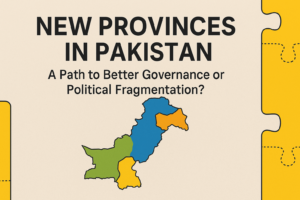New Provinces in Pakistan: A Path to Better Governance or Political Fragmentation?
Overview
The debate over creating new provinces in Pakistan has persisted for decades, resurfacing with every political and administrative crisis. Advocates argue that more provinces would ensure better governance, equitable resource distribution, and closer public representation. Critics, however, fear ethnic fragmentation, political instability, and a weakened federation. The issue demands a nuanced analysis, as it directly links with governance reforms, federalism, and national cohesion.
Key Outlines
- Introduction – Historical context of Pakistan’s provincial structure.
- Arguments in Favor of New Provinces – Governance, representation, resource management.
- Concerns Against Division – Ethnic politics, administrative costs, national unity.
- Case Studies in Pakistan – South Punjab, Hazara, Karachi province demand.
- International Comparisons – India’s reorganization of states; lessons for Pakistan.
- Constitutional & Legal Aspects – Article 239, parliamentary requirements.
- Economic Dimensions – Resource allocation, NFC award, development challenges.
- Social & Political Impact – Identity politics, minority empowerment vs polarization.
- Facts & Figures – Population distribution, resource imbalance, provincial disparities.
- Way Forward – Governance reforms vs territorial reorganization.
- Conclusion – Striking balance between administrative efficiency and national cohesion.
1. Introduction
Pakistan inherited a provincial structure of four units — Punjab, Sindh, Balochistan, and Khyber Pakhtunkhwa — with the merger of FATA into KP in 2018 as the latest adjustment. However, rising population pressures, administrative inefficiencies, and regional inequalities have reignited calls for new provinces.
2. Arguments in Favor
- Better Governance: Smaller provinces could allow local governments to function more effectively, reducing bureaucracy.
- Equitable Development: Backward regions like South Punjab or Hazara could get direct resources.
- Representation: Citizens would feel more included in governance.
3. Concerns Against
- Ethnic Politics: Risk of provinces being carved along ethnic/linguistic lines.
- High Costs: New assemblies, bureaucracy, and administrative setup would burden the economy.
- Threat to Unity: Could fuel separatist tendencies if not handled carefully.
4. Case Studies
- South Punjab: Long-standing demand due to lack of development in Multan-Bahawalpur region.
- Hazara Province: Movement gained momentum after renaming NWFP as KP.
- Karachi Province: Ethnically sensitive debate linked with urban-rural Sindh divide.
5. International Lessons
India’s 1956 States Reorganization Act allowed for decentralization, creating states on linguistic lines, but also ensured stronger federal control. Pakistan can learn from both successes and failures of such experiments.
6. Constitutional Dimensions
Under Article 239 of the Constitution, a constitutional amendment approved by two-thirds majority in both the National Assembly and the concerned Provincial Assembly is required — a high political hurdle.
7. Economic Aspects
- Pakistan’s population exceeds 240 million (2025 est.).
- Punjab alone holds over 50% of population.
- Unequal development: Punjab dominates resources, while Balochistan contributes ~30% of natural gas but remains underdeveloped.
8. Social & Political Impacts
New provinces may empower marginalized groups, but could also intensify ethnic/linguistic divides. The challenge is to balance inclusivity with unity.
Facts & Figures
- Pakistan: 4 provinces + GB + AJK (special status).
- Punjab population: ~127 million (52%).
- Balochistan: Largest area (44% of land) but only 6% of population.
- UNDP Report: Regional inequality is highest in South Punjab and interior Sindh.
- India: 28 states, 8 union territories (model of successful reorganization).
Difficult Vocabulary
- Decentralization – delegation of powers (syn: devolution | ant: centralization).
- Ethnic Fragmentation – division along ethnic lines (syn: polarization | ant: integration).
- Inequity – unfair distribution (syn: disparity | ant: fairness).
- Autonomy – self-governance (syn: independence | ant: dependence).
- Federalism – power-sharing between center and provinces (syn: confederation | ant: unitary).
- Consensus – general agreement (syn: accord | ant: discord).
- Reorganization – restructuring (syn: reshaping | ant: stagnation).
CSS-Relevant Analytical Questions
- Critically examine whether the creation of new provinces would strengthen or weaken Pakistan’s federal system.
- How can Pakistan ensure administrative efficiency without ethnic fragmentation?
- Compare Pakistan’s debate on provinces with India’s state reorganization.
- Discuss constitutional and political challenges in creating new provinces.
- Is governance reform a better solution than creating new provinces?
MCQs (CSS/PMS Style)
Q1: Which constitutional article governs the creation of new provinces in Pakistan?
a) Article 239
b) Article 140A
c) Article 245
d) Article 8
Answer: a
Q2: What percentage of Pakistan’s land is covered by Balochistan?
a) 22%
b) 30%
c) 44%
d) 50%
Answer: c
Q3: Which movement arose after NWFP was renamed Khyber Pakhtunkhwa?
a) South Punjab Movement
b) Hazara Province Movement
c) Mohajir Qaumi Movement
d) Sindhudesh Movement
Answer: b
Q4: What is Pakistan’s approximate population share of Punjab?
a) 35%
b) 42%
c) 52%
d) 60%
Answer: c
Q5: Which country provides a comparative model for successful state reorganization?
a) Afghanistan
b) Iran
c) India
d) Turkey
Answer: c
Way Forward
- Strengthen local governments before creating new provinces.
- Build political consensus to avoid ethnic polarization.
- Adopt evidence-based reorganization guided by population density, resources, and governance needs.
- Ensure constitutional safeguards to prevent misuse of power.
- Focus on inclusive development policies for marginalized regions.
Conclusion
The debate on new provinces in Pakistan is not merely about redrawing maps but about redefining governance. While smaller provinces could enhance representation and efficiency, the risk of ethnic fragmentation and political instability cannot be ignored. What Pakistan needs is a balance: governance reforms alongside well-planned provincial restructuring that prioritizes development, unity, and federal stability.


